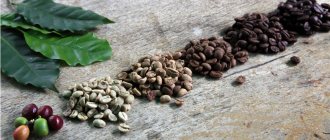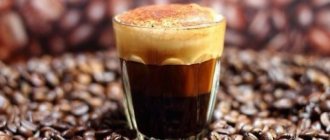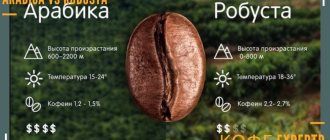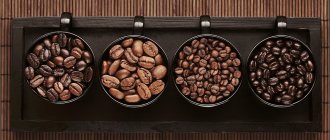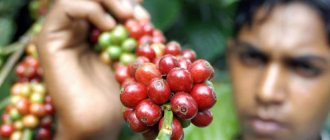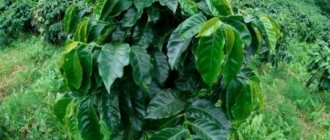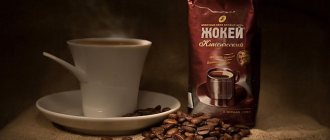More than 40 species of coffee trees grow in nature. But only two of them are usually used to produce coffee - Arabica and Robusta. Drinks made from them differ in smell and taste. Everyone will feel it. But only coffee lovers will determine what is poured in each cup. Let's find out how Arabica differs from Robusta and what it is.
Taste
The main difference between Arabica and Robusta is taste. The first type is considered softer, slightly sour. Arabica can have several shades, depending on the variety:
- fruit;
- astringent, as if with spices;
- floral;
- walnut;
- chocolate;
- berry.
Robusta will appeal to connoisseurs of strong and tart coffee. After roasting, the taste becomes slightly less bitter. A characteristic feature of this type is considered to be stable volumetric foam. Robusta is suitable for espresso lovers.
Chemical composition of grains
Robusta produces a sharp, bitter, but very invigorating infusion with a faint odor. Arabica beans contain a large amount of essential oils. The percentage of their content reaches 18%. And there is only 1.5% caffeine. After roasting, the grains are valuable for vitamin PP. Arabica also contains lipids, proteins and sugars.
Robusta is translated as “strong”, since the concentration of caffeine in it is 2 times higher than in Arabica - 3%. And there are only 8% essential oils, which explains the lack of a strong smell and taste. Roasting the beans before preparing the drink softens the bitterness slightly. A high concentration of caffeine gives a good invigorating effect, and the tart taste stimulates the receptors. As a result, a person feels less tired, so this drink is usually consumed in the morning.
Which is healthier?
Since the composition of Arabica is the most saturated with essential oils, it is considered beneficial for the body. The presence of large amounts of caffeine in Robusta helps create a strong, invigorating drink. General indicators of the benefits of coffee varieties:
- prevention of Alzheimer's disease;
- stimulation of brain activity;
- strengthening blood vessels;
- cleansing the body due to its diuretic effect.
At the same time, robusta helps control sugar levels in the body, which prevents the development of diabetes. The drink also promotes youth preservation and weight loss.
Popular varieties
Arabica may be mistakenly called a coffee variety. But in fact it is a type of plant. And the most popular varieties of coffee made from it include:
- Bourbon;
- Shinzan;
- Maragogyp;
- Typica;
- Bali;
- Katura;
- Aramosa.
Each variety has a characteristic taste and aroma. Arabica is very common and is considered a classic coffee, which is why there are so many varieties. There are significantly fewer varieties of Robusta:
- Conillon du Brazil (characteristic earthy flavor);
- Ambry (classic variety);
- Quilu (more often used in mixtures than solo).
Each variety was grown for its own purpose. Some reveal the taste of the drink better, while others grow and ripen faster. There are more varieties of Arabica, but Robusta also has plenty to choose from.
When is it open?
The homeland of robusta is Africa, first discovered in the floodplain of the Congo River. Arabica has been known to people since the 14th century. Since then, a large number of varieties and methods of roasting beans have appeared. But the classic taste of coffee has not changed since then.
Robusta was classified as a separate species only at the end of the 19th century. Before this, it was not drunk separately, but only mixed with others, so there was no need for identification. But now this type is highly valued by true lovers of strong coffee.
Features of Robusta coffee
Another name for robusta is Congo tree. Its homeland is the African continent and the territory of Asia near the equator. The literal translation of robusta is “strong”. The name arose due to the unique vitality of the tree. It can grow in conditions unsuitable for other coffee trees.
At the end of the 19th century, a leaf rust epidemic raged across Sri Lanka. Because of it, all Arabica plantations were completely destroyed, farmers suffered colossal losses and were on the verge of ruin. Viable robusta turned out to be a salvation. These trees were massively planted in all plantations in Sri Lanka, and then in Madagascar and Brazil.
Coffee made from robusta beans was in demand in the domestic market. But at the first attempt to export, farmers failed. Consumers in Europe brewed coffee in a Turk, thereby increasing the bitterness and strength of Robusta. In addition, increased caffeine content inevitably led to increased heart rate and increased blood pressure. Commercial demand for Robusta has not met expectations.
The Robusta variety includes several subspecies, the most popular of which are ambri, conillon and bought.
Where does it grow
Mountain areas are better suited for cultivating Arabica. The optimal altitude above sea level for this plant is 600-2000 m. Arabica does not like heat; the optimal temperature for growth and ripening is from 15 to 24°C. Precipitation should be from 1200 to 2000 mm per year. If there are more of them, the tree may begin to rot.
Robusta trees prefer foothills and flat terrain. Robusta does not like heights too much; it is grown on land up to 800 m above the sea. But this plant requires heat and moisture. The tree grows best at temperatures from 16 to 36°C, and requires a rainfall of 2000 to 3000 mm. If climatic conditions do not meet the norm, the plant will dry out and die.
Appearance of grains
Arabica and Robusta beans differ significantly in appearance. In the first species they reach up to 8 mm and have an oval shape. After roasting, the beans have an even brown color.
The shape of the Robusta grain is closer to a circle. They are smaller in size than Arabica beans. After roasting, the color of the beans does not become uniform; they can have several shades of brown.
Plant size
Since Arabica grows in high mountain areas, it has a small trunk height. The maximum size of a tree is 5 m. In conditions of low rainfall and low temperatures, growing higher is simply irrational; the plant will not have enough nutrients.
Robusta grows in flat areas, so the tree can reach 10-12 m. Climatic conditions with high rainfall do not limit the plant in nutrients and water. And the distance from the sun's rays provokes the tree to grow in height. Therefore, Robusta is almost 2 times higher than Arabica.
whimsicality
Growing Arabica is more difficult due to climatic restrictions. It can also be affected by parasites and diseases. This is due to the low concentration of caffeine, which can prevent infection.
Caring for a robusta tree is easier. It is suitable for a wider range of climatic conditions, and is also not afraid of parasites and diseases. Due to caffeine, which is 2 times more than in Arabica, pathogens do not affect Robusta beans. The yield of this species is also higher, as conditions with high rainfall suit it, which stimulates the growth and ripening of fruits.
Basic historical facts
- Place of discovery: The first mentions of Arabica were in Ethiopia, and Robusta in Uganda.
- Places of growth: Arabica is cultivated in America, Africa, Asia, the Caribbean and Oceania. Robusta is mainly cultivated on an industrial scale in Asia and Africa.
- Leader in production: Leader in Arabica production - Brazil, Robusta - Vietnam.
- Share in world production: 70% of the world volume belongs to Arabica, 30% to Robusta.
- Characteristics of the coffee tree
- Tree height: Arabica can grow up to 10 meters, robusta up to 15 meters.
- Growing altitude: Arabica grows from 900 to 2500 meters above sea level, robusta grows lower, from 200 to 900 meters.
- Resistance to parasites and diseases: Arabica is less resistant to diseases, robusta, on the contrary, has high resistance to parasites and diseases.
Usage
Arabica and Robusta differ in purpose. The first type is used in its pure form; an aromatic, weak drink is prepared from it. And the second is suitable for espresso, as it has a powerful invigorating effect. It is also added to mixtures for making coffee, and is also used as a base for creating instant drinks. Robusta is drunk in its pure form only by true connoisseurs who like its bitterness and tart taste.
Popularity in the world
It is interesting to know which coffee is more popular. Arabica accounts for 70–75% of the volume of coffee produced. It is more popular among lovers of a natural drink, which is brewed using a kettle.
Can you guess which coffee is more popular for the production of instant drinks? The main purpose of a soluble analogue of grains is to enable people to cheer up inexpensively in the morning. Therefore, most manufacturers use robusta or a mixture in which the proportion of its content is maximum for its production.
Cost of Arabica and Robusta
The price of arabica is usually higher than that of robusta. This is due to the peculiarities of growing the species, as well as its taste characteristics. But there are also expensive, rare varieties of Robusta. Although the average cost of this type is several times lower compared to Arabica. This is explained by the low taste of robusta and the unpretentiousness of the tree to external conditions.
Arabica and Robusta are different types of coffee, each of which includes several varieties. They are completely different in taste, and their climatic and geographical conditions are completely different. Therefore, it is not difficult to make a choice between Arabica and Robusta, you just need to try them.
Famous brands make their products from these two types of coffee: Dallmeier, Lavazza, Carte Noir, Paulig, about which you can learn a lot of interesting and useful information on our website.
Let's try it already!
Robusta behaves well in a team with Arabica. Yes, in a small percentage, but still in the team! In our case, this is not an attempt to somehow make coffee cheaper, but a creative process of creating a completely new story, the plot idea of which depends on each individual character and the entire gang at the same time.
For example, in our blends we use high-quality robusta from India, which we will introduce you to at the end, in collaboration with overseas ambassadors of purebred Arabica. You can understand everything about the nature of the result by simply listing the main participants in this presentation:
Coffee mixture "Chocolate Express"
A duet of Latin American Arabica Brazil Santos and Robusta India Cherie. Yes, chocolatey, slightly spicy Brazilian and strong Indian with nutty, tobacco and woody notes.
We called this mixture “Chocolate Express”, and it is simply ideal for brewing in a Turk and just as wonderful in a coffee machine. Characteristic foam, bitterness and strength are guaranteed!
Coffee mixture "Chocolate"
The second mixture that we cannot remain silent about is “Chocolate”, and here you will also immediately guess that we are talking about thick, rich, bittersweet coffee, similar in taste and character to a bar of dark chocolate.
This coffee is a light roast, which is a great excuse to get out your French Press, just brew it in a cup, or even try out how chocolaty it would be in a filter.
